密码学家族:Blum, Blum和Blum
- asecuritysite
- 发布于 2023-05-22 15:33
- 阅读 835
本文介绍了密码学领域中Blum家族(Manuel Blum, Lenore Blum和Avrim Blum)的贡献。他们共同在伪随机数生成器(如Blum Blum Shub),公钥加密系统(Blum-Goldwasser)和CAPTCHA等领域做出了重要贡献,并对后来的密码学和人工智能研究产生了深远影响。

来源: [ 维基百科]
家族密码学:Blum、Blum 和 Blum
我们口袋里的智能手机背后是几十年扎实的研究进展。而这些研究的背后是人。而且,这些人充满热情地解决实际问题并分享他们的知识。而且,有时这项工作是家族式的。
所以,昨天我发表了一篇关于 Lenstra 兄弟对数学和密码学的贡献的文章[ 这里],所以让我们看看另一个家族:Blum 家族。
Manuel Blum 和 Lenore Blum 这对夫妇都是卡内基梅隆大学的教授。但是,他们两人都在 2018 年辞职,以抗议研究项目中的性别歧视待遇。Avrim(他们的儿子,也包含在本文顶部的照片中)也遵循了家族路线,成为卡内基梅隆大学的计算机科学教授。事实上,他的博士导师是密码学天才 Ron Rivest。
像他的父母一样,Avrim 在复杂性理论和机器学习的许多领域都取得了进展[ 这里]:

就像他们的儿子一样,Manuel 和 Lenore 为研究领域提供了很多伟大的东西。其中包括 Blum 整数、Blum-Blum Shub 随机数生成器、Blum-Goldwasser 公钥加密系统和 CAPTCHA 的发明。而且,Manuel 也是许多博士生的杰出导师,包括 Len Adleman、Shafi Goldwasser 和 Silvio Micali。这是 Silvio 和 Manual 共同撰写的一篇经典论文:
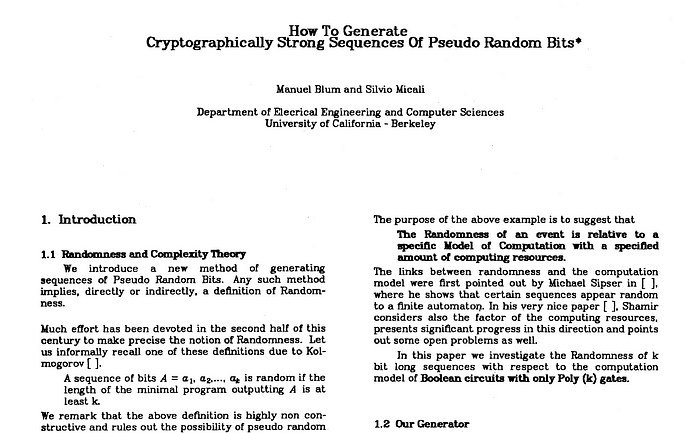
他是一位鼓舞人心的博士生导师,你可以看出他非常关心他的学生 [ 这里]:
在攻读博士学位时,你必须专注于一个非常狭窄的主题,以便能够完全理解它。一开始,你似乎在研究一根谚语中的针,它是世界的一小部分,是一颗微小的晶体,美丽但从整个事物来看,却是微不足道的。与它一起工作。你越是与它合作,你就越深入地了解它,你就越会发现你的工作,你的主题,包含着整个世界。随着时间的推移,你将会看到你沙粒中的世界。
在一粒沙子里看到一个世界
或在野花中看到天堂,
在你的手掌中握住无限
并在一个小时内握住永恒。
威廉·布莱克 (1757-1827)"以及不断写作(和学习)的重要性:
我记得麻省理工学院的一位数学教授,
名字叫 BERTRAM KOSTANT,
每当他在办公室时,他都会敞开门,而且他总是坐在书桌前写作。
写作。一直在写作。
他是在写他的研究吗?也许吧。
他是在写他的想法吗?也许吧。
我个人认为他是在阅读,并在写他所阅读的内容。
至少对我来说,写下我所阅读的内容是学习复杂材料最愉快和最有益的方式之一。我个人认为这是一个很好的建议,因为我写书和我的网站,是因为我正在学习这些主题。
Blum 和 Blum
Manuel 和 Lenore 的第一篇合作论文之一发表于 1975 年 [ [这里](http://Toward a mathematical theory of inductive inference)][1]:
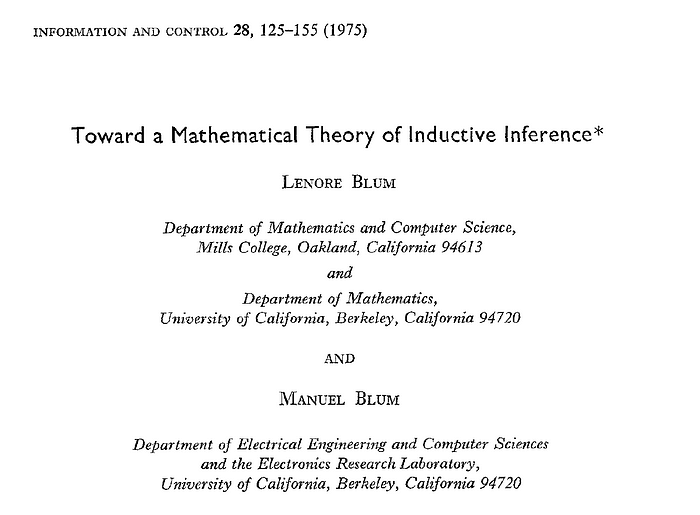
但是,在 1986 年,Lenore 和 Manuel 概述了现有的最好的可证明伪随机数生成器之一……Blum Blum Shub (BBS) 方法 [ 这里]:
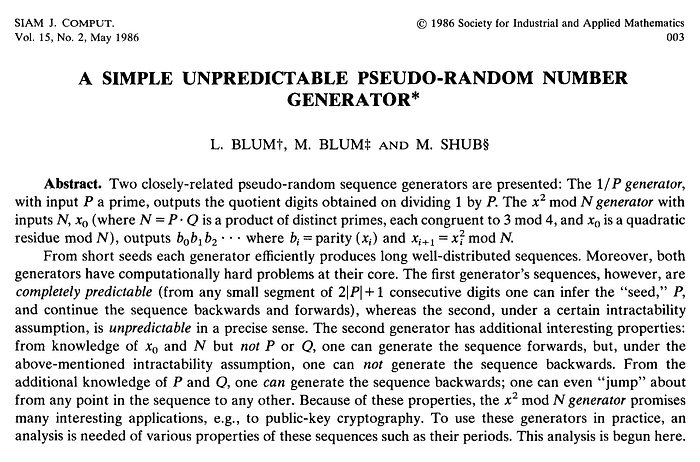
它使用的形式是:

其中 x_0 是一个随机种子。M 的值等于 pq,其中 p 和 q 是素数。p 和 q 的这些值都与 3 模 4 同余(p = q = 3 (mod4) )。这意味着什么? 好吧,当我取 p 或 q 的值并将其除以 4 时,我将得到余数 3。
所以,p=7 是可能的(因为 7 除以 4 是 1,余数是 3),p=11 也是可能的(因为 11 除以 4 是 2,余数是 3)。13 的值是不可能的,因为它将是 3,余数是 1。让我们在 Python 中尝试一个简单的例子 [ 这里]:
>>> p=7
>>> q=11
>>> M=p*q
>>> x0=5
>>> x1=(x0**2)%M
>>> x2=(x1**2)%M
>>> x3=(x2**2)%M
>>> x4=(x3**2)%M
>>> print (x1,x2,x3,x4)
25 9 4 16在本例中,我们使用 p=7 和 q=11,然后使用种子 x_0=5,随机序列是 25、9、4 和 16。我们通常只取最低有效位,所以输出将是“1100”。
该方法的安全性涉及分解 M 的难度。总的来说,它很慢,但它是经过验证的最强大的随机数生成器。对于每个步骤,我们从 x_n +1 中提取一些信息,这些信息通常是最低有效位。它不会在密码应用程序中使用,但可以在密钥生成中使用。
使用的代码是 [ 这里]:
import sympy
import random
import re
import sys
x = 3*10**10
y = 4*10**10
seed = random.randint(1,1e10)
def lcm(a, b):
"""Compute the lowest common multiple of a and b""" # 计算 a 和 b 的最小公倍数
return a * b / gcd(a, b)
def gcd(a,b):
"""Compute the greatest common divisor of a and b""" # 计算 a 和 b 的最大公约数
while b > 0:
a, b = b, a % b
return a
def next_usable_prime(x):
p = sympy.nextprime(x)
while (p % 4 != 3):
p = sympy.nextprime(p)
return p
p = next_usable_prime(x)
q = next_usable_prime(y)
M = p*q
N = 1000
if (len(sys.argv)>1):
N=int(sys.argv[1])
print "\np:\t",p
print "q:\t",q
print "M:\t",M
print "Seed:\t",seed
x = seed
bit_output = ""
for _ in range(N):
x = x*x % M
b = x % 2
bit_output += str(b)
print bit_output
print "\nNumber of zeros:\t",bit_output.count("0") # 零的数量
print "Number of ones:\t\t",bit_output.count("1") # 壹的数量
xi=''
print "\nPredicting 1st 10 with Euler's Theorem:" # 使用Euler定理预测前 10 个
for i in range(10):
xi += str((seed ** (2**i % lcm((p-1),(p-1))) % M) %2)
print xi一个示例运行是 [ 这里]:
p: 30000000091
q: 40000000003
M: 1200000003730000000273
Seed: 2188162291
1011001011011110101101110001011000110001000010110110010100011110011010011100000001011111101100100101
Number of zeros: 49
Number of ones: 51这是我的解释:
Blum 整数
让我们看看 Blum 整数的魔力——它是以 Manuel 的名字命名的。这些与以下形式的求解有关:
y = x² mod n
我们需要为不同的 x 值以及给定的模数 (n) 找到 y 值。例如,如果我们有:
4 = x² (mod 15)
x 的有效值是 2、7、8 和 13。但有时没有解决方案,例如 x=3。
Blum 整数是通过将两个素数(p 和 q)相乘而创建的,其中 p=3 (mod 4) 且 q = 3 (mod 4):
n=p * q
因此,我们取素数(p 和 q)并将它们除以 4,如果我们得到 3 的答案,我们就得到了所需的值。例如,7 是一个可能的值,因为当我们除以 4 时,我们得到 3。可能的素数是:3、7、11、19 等。然后 Blum 整数变为:21、33、57、69、77、93、129、133、141、161、177、201、209、213、217、237、249、…。
现在,这些具有有趣的属性。首先是当我们确定一个值的模平方根时,我们得到四个平方根。让我用一个例子来说明这一点。假设我有 p=47 和 q=43:
47 = 3 (mod 4) [因为这是 15 r 3]
43 = 3 (mod 4) [因为这是 14 r 3]
我们发现 N 为:
N = 47*43 = 2,021
接下来,我们发现对于 0 到 N 之间的每个值,都有四个平方根值。让我们选择一个值 y =4。为此,4= x²(mod 2021) 中 x 的解是:
1976^2=4 (mod 2021)
2^2=4 (mod 2021)
2019^2=4 (mod 2021)
45^2=4 (mod 2021)例如,1,972²² = 3,904,576,然后如果我们取 (mod 2,021),我们得到 4。因此,我们的 Blum 整数总是给出我们四个模平方根。这是一个计算其中一些的小程序 [ 这里]:
import sys
import libnum
p=0
q=0
bitsize=8
if (len(sys.argv)>1):
bitsize=int(sys.argv[1])
while ((p%4)!=3):
p=libnum.generate_prime(bitsize)
while ((q%4)!=3):
q=libnum.generate_prime(bitsize)
print ("\nPrime (p): %d. Length: %d bits, Digits: %d" % (p,libnum.len_in_bits(p), len(str(p)) )) # 素数(p):%d。长度:%d 位,位数:%d
print ("\nPrime (q): %d. Length: %d bits, Digits: %d" % (q,libnum.len_in_bits(q), len(str(q)) )) # 素数(q):%d。长度:%d 位,位数:%d
n=p*q
print ("N=",n)
print ("The first few values:") # 前几个值:
for x in range(2,12):
if (libnum.has_sqrtmod(x,{p: 1,q:1})):
res=libnum.sqrtmod(x,{p: 1,q:1})
y=next(res)
print (" %d^2=%d (mod %d)" % (y,x,n))
y=next(res)
print (" %d^2=%d (mod %d)" % (y,x,n))
y=next(res)
print (" %d^2=%d (mod %d)" % (y,x,n))
y=next(res)
print (" %d^2=%d (mod %d)" % (y,x,n))
print ()这是代码:
Blum-Goldwasser 概率加密
使用公钥加密,Alice 可以发送给 Bob 两个可能的消息(“0”或“1”)。如果 Eve 知道可能的消息(“0”或“1”),她将使用 Bob 的公钥对每个消息进行加密,然后将结果与 Alice 发送的密码消息进行匹配。因此,Eve 可以确定 Alice 发送给 Bob 的内容。为了克服这个问题,Blum-Goldwasser 方法是一种公钥算法,它使用概率公钥加密方案 [ 这里][2]:
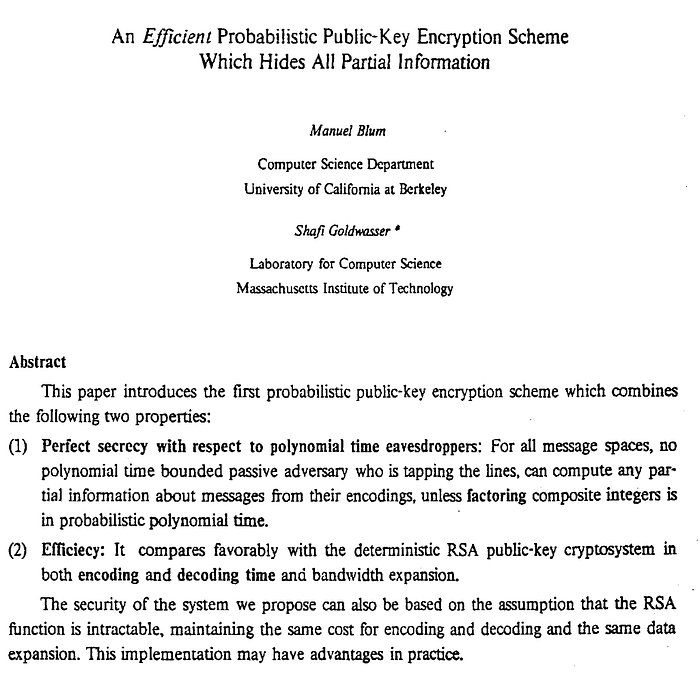
加密方法使用 Blum-Blum-Shub (BBS) 技术来生成密钥流[ 这里]。最初,我们创建两个素数(p 和 q),然后计算 N:
N = pq
公钥是 N,私钥是 p 和 q,其中 p 和 q:
p (mod 4) = 3
q (mod 4) = 3
例如,我们可以选择 p= 239、q= 179,因为当我们执行 (mod 4) 运算时,两者都会给我们 3:
>>> p=239
>>> q=179
>>> p%4
3
>>> q%4
3维基百科定义的基本方法是:
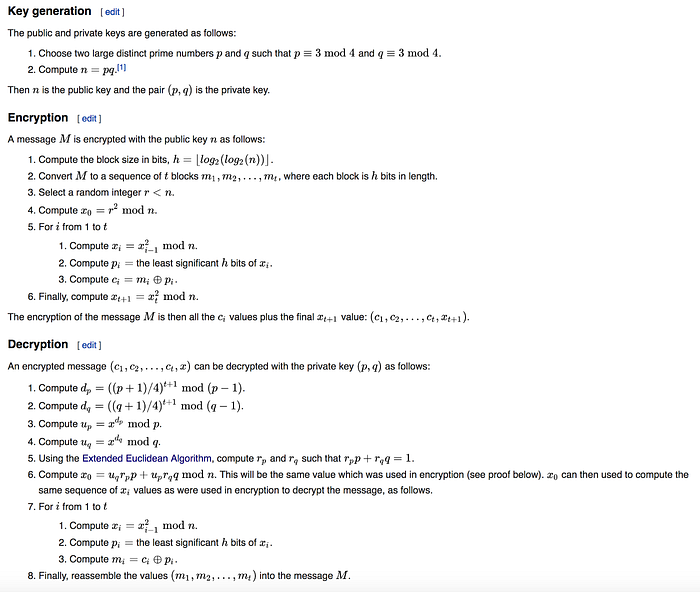
代码如下[ 这里]:
import numpy as np
import binascii
import Crypto.Util.number
from Crypto import Random
import sys
import random
def xgcd(a, b):
"""return (g, x, y) such that a*x + b*y = g = gcd(a, b)""" # 返回 (g, x, y) 使得 a*x + b*y = g = gcd(a, b)
x0, x1, y0, y1 = 0, 1, 1, 0
while a != 0:
(q, a), b = divmod(b, a), a
y0, y1 = y1, y0 - q * y1
x0, x1 = x1, x0 - q * x1
return b, x0, y0
# Method from https://stackoverflow.com/questions/7396849/convert-binary-to-ascii-and-vice-versa
def to_bits(text, encoding='utf-8', errors='surrogatepass'): # 来自 https://stackoverflow.com/questions/7396849/convert-binary-to-ascii-and-vice-versa 的方法
bits = bin(int(binascii.hexlify(text.encode(encoding, errors)), 16))[2:]
return bits.zfill(8 * ((len(bits) + 7) // 8))
def from_bits(bits, encoding='utf-8', errors='surrogatepass'):
n = int(bits, 2)
return int2bytes(n).decode(encoding, errors)
def int2bytes(i):
hex_string = '%x' % i
n = len(hex_string)
return binascii.unhexlify(hex_string.zfill(n + (n & 1)))
# Derived from https://github.com/coenvalk/blum-goldwasser-probabilistic-encryption/blob/master/blumgoldwasser.py
def BGW_enc(p, q, x, m): # 来源于 https://github.com/coenvalk/blum-goldwasser-probabilistic-encryption/blob/master/blumgoldwasser.py
n = p * q
# assert p%4 == 3 and q%4 == 4
k = int(np.log2(n))
h = int(np.log2(k))
t = len(m) / h
xi = x
c = ''
for i in range(t):
mi = m[i*h:(i + 1)*h]
xi = (xi ** 2) % n
xi_bin = bin(xi)
pi = xi_bin[-h:]
mi_int = int(mi, 2)
pi_int = int(pi, 2)
ci = pi_int ^ mi_int
ci_bin = format(ci, '0' + str(h) + 'b')
c += ci_bin
xt = (xi ** 2) % n
return c, xt
def BGW_dec(p, q, a, b, xt, c):
assert a*p + b*q == 1
n=p*q
k = int(np.log2(n))
h = int(np.log2(k))
t = len(c) / h
d1 = (((p + 1) / 4)**(t + 1)) % (p - 1)
d2 = (((q + 1) / 4)**(t + 1)) % (q - 1)
u = pow(xt,d1,p)
v = pow(xt,d2, q)
x0 = (v*a*p + u*b*q) % n
xi = x0
m = ''
for i in range(t):
ci = c[i*h:(i + 1)*h]
xi = (xi**2) % n
xi_bin = bin(xi)
pi = xi_bin[-h:]
ci_int = int(ci, 2)
pi_int = int(pi, 2)
mi = pi_int ^ ci_int
mi_bin = format(mi, '0' + str(h) + 'b')
m += mi_bin
return m
p = 499
q = 547
bits=10
msg='Hello'
if (len(sys.argv)>1):
bits=int(sys.argv[1])
if (len(sys.argv)>2):
msg=(sys.argv[2])
while True:
p=Crypto.Util.number.getPrime(bits, randfunc=Crypto.Random.get_random_bytes)
if (p%4==3): break
while True:
q=Crypto.Util.number.getPrime(bits, randfunc=Crypto.Random.get_random_bytes)
if (q%4==3): break
m=to_bits(msg)
a=1
b=1
_,a,b=xgcd(p,q)
r= random.getrandbits(bits)
x0 = (a*p*r + b*q+r) % (p*q)
c, xt = BGW_enc(p, q, x0, m)
print ("Message: %s" % msg) # 消息:%s
print (" %s" % m)
print ("\nNo of bits in prime is %d" % bits) # 素数中的位数是 %d
print ("p= %d" % p)
print ("q= %d" % q)
print ("a= %d" % a)
print ("b= %d" % b)
print ("r= %d" % r)
print ("x0= %d" % x0)
print ("ap+bq: %d" % (a*p+b*q))
print "\nCiphertext:", c
d = BGW_dec(p, q, a, b, xt, c)
print ("Decrypted: %s" % from_bits(d)) # 解密:%s一个示例运行是 [ 这里]:
Message: Hello
0100100001100101011011000110110001101111
No of bits in prime is 16
p= 65447
q= 34231
a= -7482
b= 14305
r= 37115
x0= 1908144401
ap+bq: 1
Ciphertext: 0011100101011111010000110011100011010010
Decrypted: HelloCAPTCHA
当然,最后,我们来看看旨在区分人和机器人的在线系统 [3]:
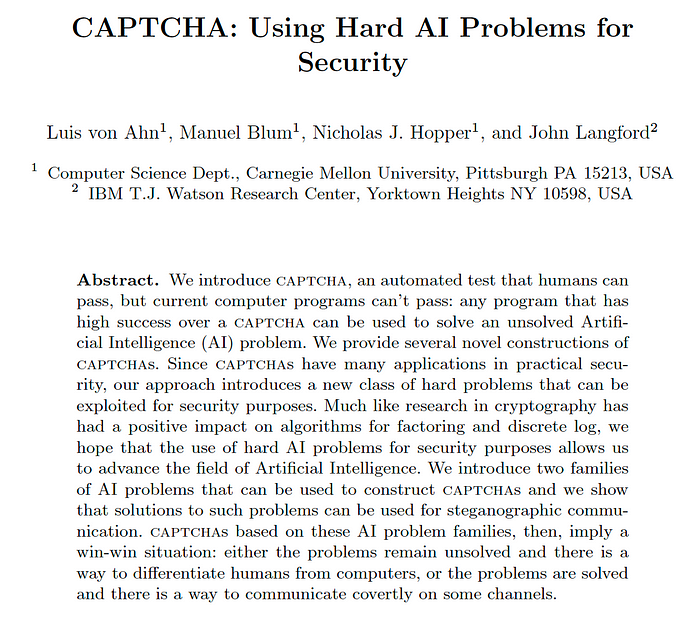
这是将密码学和人工智能领域结合在一起的首批论文之一,Avrim 将继续研究该领域。
结论
研究领域非常感谢 Manuel、Lenore 和 Avrim。没有他们,我们的世界会更加复杂和缺乏信任。有时,密码学是与生俱来的。而对于研究?它存在于他们的 DNA 中:
并且:
参考文献
[1] Blum, L., & Blum, M. (1975). Toward a mathematical theory of inductive inference. Information and control, 28(2), 125–155.
[2] Blum, M., & Goldwasser, S. (1984, August). An efficient probabilistic public-key encryption scheme which hides all partial information. In Workshop on the theory and application of cryptographic techniques (pp. 289–299). Springer, Berlin, Heidelberg.
[3] Ahn, L. V., Blum, M., Hopper, N. J., & Langford, J. (2003, May). CAPTCHA: Using hard AI problems for security. In International conference on the theory and applications of cryptographic techniques (pp. 294–311). Springer, Berlin, Heidelberg.
- 原文链接: medium.com/asecuritysite...
- 登链社区 AI 助手,为大家转译优秀英文文章,如有翻译不通的地方,还请包涵~
- 翻译
- 学分: 0
- 分类: 密码学
- 标签: Manuel Blum Lenore Blum Avrim Blum Blum整数 Blum-Blum-Shub CAPTCHA
- 破解近乎单向函数 1078 浏览

